Harnessing the Power of History: An Opening Perspective
Debt crowdfunding has transformed how borrowers access capital and how investors build diversified portfolios. Yet, beneath the promise of attractive yield and portfolio diversification lies a persistent specter: default risk. For investors and platforms alike, gauging which borrowers are most likely to fall behind or fail to repay is a high-stakes puzzle. Fortunately, the key to solving much of that riddle resides in historical data—the patterns, trends, and behaviors of past loans that can illuminate the road ahead. By meticulously gathering and analyzing this wealth of information, stakeholders can develop predictive frameworks that identify high-risk segments, optimize underwriting criteria, and ultimately secure stronger, more resilient portfolios.
In this guide, we’ll embark on a journey through the art and science of using historical data to forecast default risk in debt crowdfunding. From identifying the most potent data sources to applying sophisticated statistical and machine learning techniques, we’ll explore how informed predictions give investors a decisive edge. Along the way, you’ll discover how even subtle insights—like seasonality in repayment patterns or shifts in borrower demographics—can translate into concrete strategies to mitigate losses. Buckle up as we delve into the dynamic intersection of data analytics and debt-based crowdfunding, where past performance paves the way to future certainty.
Collecting and Curating Robust Historical Data Sets
Before predictions can thrive, the foundation of reliable data must be laid. Historical loan data in debt crowdfunding often spans thousands, sometimes tens of thousands, of individual notes—each containing a tapestry of borrower attributes, loan terms, performance metrics, and external context. The first step is gathering these raw inputs from platforms, third-party data aggregators, and public financial reports. Investors may need to partner with platforms that transparently disclose loan histories, default timelines, and recovery rates. Where direct access is limited, some turn to APIs or web-scraping tools to compile comprehensive datasets.
Once collected, the data must be curated to ensure accuracy and consistency. This involves reconciling discrepancies—such as mismatched date formats, inconsistent status labels (e.g., “late” vs. “delinquent”), and missing fields in borrower profiles. Rigorous cleansing procedures detect and exclude anomalies: loans that were refinanced mid-term, fraudulent entries, or one-off adjustments that don’t reflect organic borrower behavior. During curation, it’s also crucial to preserve anonymized identifiers that allow linking borrower characteristics (like credit grade, employment sector, or geographic region) with performance outcomes. By transforming disparate records into a cohesive database, analysts lay the groundwork for reliable statistical insights and predictive modeling.
Identifying Key Metrics That Foretell Default
With a pristine historical dataset in hand, the next imperative is discerning which metrics truly correlate with increased default likelihood. Not all data points wield equal predictive power; some serve as mere noise, while others signal imminent risk. Among the most potent indicators are credit-related markers—such as past delinquencies, current debt-to-income ratios, and credit utilization rates. Borrowers with a pattern of late payments on previous obligations frequently exhibit similar behavior in new crowdfunding loans. Similarly, high credit utilization—when a borrower carries balances close to credit limits—can signal financial overextension.
Beyond credit factors, loan attributes also matter. Loan-to-value ratios for secured crowdfunding notes, interest rate spreads relative to peer loans, and scheduled repayment frequency (monthly versus biweekly) can influence default probabilities. Seasonality can play a surprising role: borrowers in seasonal industries—such as tourism or agriculture—may show elevated default risk during off-peak revenue months. Macroeconomic variables also intersect with borrower behavior. Rising unemployment rates, shifts in interest rate policy, and regional economic downturns can amplify default rates in an otherwise healthy cohort. By systematically analyzing how each metric correlates with loan performance, investors can weigh data-driven factors more heavily when constructing risk models.
Trend Analysis: Revealing Patterns Over Time
Patterns that emerge when examining loan performance over extended periods often hold insights that static snapshots cannot. Time-series analysis shines a spotlight on how default rates ebb and flow in response to external forces. For example, if a platform observes that defaults peaked during the winter months across several consecutive years, it suggests a seasonal component—perhaps tied to borrower industries or holiday overspending. Similarly, tracking borrower cohorts by origination year can reveal whether underwriting criteria adjustments (like raising minimum credit score requirements) correspond to improved loan performance in subsequent cycles.
Another trend-focused inquiry examines how macroeconomic shocks translate into regional or borrower-segment stress. During a localized economic downturn—say, a manufacturing plant shutdown—loans from that geographic area may exhibit correlated spikes in delinquency. By charting these twists and turns across market cycles, analysts refine their forecasts to incorporate not only borrower-specific data but also broader economic indicators. Such dynamic trend analysis transforms historical data from static entries into a living tapestry, where every peak and valley offers clues about potential future outcomes.
Building Predictive Models: From Regression to Machine Learning
Once metrics with predictive potential are identified, the next step involves crafting models that quantify default risk. Traditional statistical techniques, such as logistic regression, enable analysts to estimate the probability that a borrower with certain characteristics will default. By assigning weights to each variable—credit score, DTI, employment industry, and so on—regression models produce a risk score that can be applied to new loan applications. While straightforward and interpretable, these models may struggle with non-linear relationships or interactions between variables.
Enter machine learning methods—random forests, gradient boosting machines, and neural networks—which excel at capturing complex, high-dimensional patterns in historical data. A random forest model, for example, constructs multiple decision trees that segment borrower populations based on recurring split criteria—credit utilization thresholds, minimum liquid assets, or maximum monthly payment ratios. By averaging predictions across these trees, the model yields robust default probabilities. Gradient boosting machines iteratively refine models by focusing on previously misclassified loans, continuously enhancing predictive accuracy. Neural networks, particularly deep learning frameworks, can detect subtle, non-intuitive interactions—like how a moderate credit score combined with a specific industry affiliation increases default risk under certain economic conditions.
Yet, with greater complexity comes a trade-off: explainability often diminishes as models grow more intricate. Seasoned investors and platforms strike a balance by using simpler models for initial screening—flagging high-risk applicants early—and deploying advanced algorithms in subsequent, more focused evaluations. This layered approach ensures interpretability when communicating risk thresholds to stakeholders, while still harnessing the power of cutting-edge analytics to optimize ROI through reduced default exposure.
Validating Models Through Backtesting and Cross-Validation
A predictive model’s true worth emerges only when its forecasts align with real-world outcomes. Backtesting involves applying a model retrospectively to historical data—segmenting loans into development and validation periods. If the model predicted high default probabilities for a cohort of loans originated in 2018, analysts check how many of those loans indeed defaulted by 2020. Discrepancies highlight model biases: perhaps the algorithm underestimates risk for certain subgroups, such as borrowers with irregular income streams.
Cross-validation further strengthens confidence in model performance by repeatedly partitioning the dataset and measuring prediction accuracy across multiple folds. By rotating through different subsets, analysts reduce the likelihood that their model simply memorized idiosyncratic patterns in one particular slice of data. Metrics like the Area Under the Receiver Operating Characteristic Curve (AUC-ROC) and precision-recall scores quantify how effectively the model distinguishes between defaulting and non-defaulting loans. When backtesting and cross-validation yield consistently strong results—high AUC values above 0.8, narrow confidence intervals on predicted default rates—investors gain confidence in deploying these tools to assess the viability of new lending opportunities.
Integrating External Economic Indicators for Holistic Insights
While borrower-specific factors carry immense predictive weight, coupling them with macroeconomic signals enhances model robustness. A spike in oil prices, for instance, may erode disposable income in energy-dependent regions, foreshadowing heightened default rates among borrowers who rely on those local industries. Similarly, a contraction in consumer confidence or an uptick in inflation can tighten household budgets, triggering repayment struggles even among borrowers with previously pristine credit histories.
To capture this interplay, analysts integrate time-varying economic indicators—unemployment rates, consumer price indices, GDP growth figures—into predictive models. By aligning these variables with loan performance timelines, they gauge how defaults have historically responded to economic shifts. This multifaceted approach ensures that risk assessments extend beyond isolated borrower snapshots, encompassing the broader context in which those borrowers operate. As indicators fluctuate, the model can dynamically adjust default risk scores for active loans, prompting early interventions or portfolio rebalancing when macroeconomic headwinds materialize.
Case Study: Real-World Successes and Pitfalls
Consider a mid-sized P2P platform that, in 2017, experienced a surge in defaults among small business loans oriented toward retail storefront expansions. A thorough review of historical data revealed that borrowers with DTI ratios exceeding 40 percent, combined with less than three years of operational history, were most susceptible to default. Armed with these insights, the platform adjusted its underwriting parameters—raising the minimum operational history from two to three years for retail loans and capping DTI at 35 percent. Within eighteen months, default rates in that segment fell by nearly 25 percent, boosting overall portfolio performance and investor ROI.
Yet, even data-driven strategies can falter when new, unexpected variables emerge. In 2020, a global pandemic disrupted long-standing historical patterns, particularly in sectors like hospitality and leisure. Platforms that relied solely on pre-pandemic data without accommodating for the sudden, severe economic contraction saw their models misclassify risk—leading to elevated losses. This cautionary episode underscores a vital lesson: historical data is most powerful when updated in real-time and complemented by forward-looking scenario analyses that anticipate unprecedented shocks.
Translating Predictions into Risk Mitigation Strategies
Forecasting default risk is not an academic exercise; its true value lies in the concrete strategies that spring from those predictions. Once high-risk borrower profiles are flagged, platforms and investors can adjust yield expectations, impose tighter covenants, or require additional collateral to cushion potential losses. In some cases, automated decision engines may decline high-risk applications outright, directing borrowers to alternative funding methods better suited to their risk profiles.
Moreover, dynamic portfolio rebalancing leverages predictive scores to shift capital away from loans with rising risk metrics. If a borrower’s default probability ticks upward due to unexpected personal or economic circumstances, platforms may accelerate collections efforts or engage third-party servicing to negotiate modified repayment plans. Customized interventions—like temporary payment deferrals for borrowers facing short-term hardship—have proven more cost-effective than allowing accounts to slip deeper into delinquency. By aligning operational responses with predictive analytics, stakeholders transform raw data into precision-targeted loss prevention campaigns that bolster ROI.
Staying Ahead: Continuous Model Refinement and Feedback Loops
The work of prediction seldom ends once a model enters production. As new loans mature—either repaying in full or succumbing to default—their outcomes feed back into the historical database, enriching future analyses. Continuous monitoring and periodic retraining are imperative to prevent model degradation. As lending environments evolve—shaped by technological advances, shifting consumer behaviors, or regulatory reforms—predictive algorithms must adapt in step. For instance, the rise of alternative data sources—such as social media sentiment, mobile banking activity, and psychometric assessments—offers additional layers of insight into borrower reliability. Integrating these novel signals can elevate model accuracy but also introduces fresh complexities in data governance and privacy.
Regular performance audits assess whether the model’s error rates remain within acceptable bounds. If prediction accuracy dips below thresholds—perhaps triggered by unforeseen market disruptions—data science teams revisit feature selections, adjust weighting schemes, or explore new modeling techniques. By embedding a culture of continuous refinement, stakeholders prevent stagnation and ensure that their predictive frameworks stay attuned to both borrower behavior and macroeconomic currents. This proactive stance transforms historical data from a static reservoir into a living, adaptive resource that evolves with the lending ecosystem.
Looking Forward: The Future of Predictive Risk Analytics
The confluence of data availability, advances in machine learning, and ever-expanding alternative data streams heralds a new era for default risk prediction in debt crowdfunding. Real-time credit monitoring tools can detect borrower distress signals—such as sudden spikes in credit card balances or abrupt job losses—before traditional data points register a change. Natural language processing can sift through customer reviews, social media chatter, and news articles to surface hidden risk factors tied to specific industries or geographic clusters. Meanwhile, blockchain-based credit ledgers promise a transparent, tamper-proof history of borrower activity that may further sharpen predictive accuracy.
As predictive analytics matures, ethical considerations and regulatory scrutiny will intensify. Ensuring that models do not perpetuate bias—whether against certain demographics, industries, or socioeconomic groups—will be paramount. Responsible data stewardship demands transparency in how predictive scores influence borrower outcomes, whether in loan approvals or pricing decisions. By marrying technological innovation with a commitment to fairness and privacy, the debt crowdfunding community can unlock the full promise of historical data—creating a virtuous cycle that empowers investors, supports responsible borrowers, and fortifies the health of this transformative lending paradigm.
Deploying historical data to forecast default risk in debt crowdfunding marries the rigor of quantitative analysis with the nuance of human judgment. By collecting and curating comprehensive loan histories, identifying the most telling metrics, and applying advanced statistical or machine learning models, stakeholders can predict which borrowers stand on solid footing and which ones may falter. Integrating external economic indicators, learning from real-world case studies, and translating predictions into tailored risk mitigation strategies further strengthen portfolios against unwanted losses. Yet, the work does not conclude with a one-time model; continuous refinement—fueled by fresh data and ever-evolving analytical tools—ensures that risk assessments remain agile and relevant. As the debt crowdfunding landscape matures, the marriage of data-driven foresight with ethical, transparent practices will define long-term success, elevating default risk prediction from a mere statistical exercise into a cornerstone of sustainable, equitable finance.




